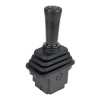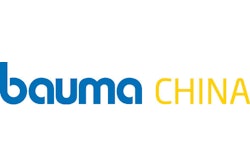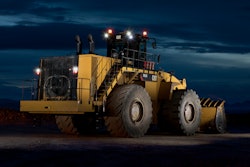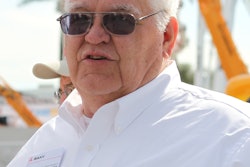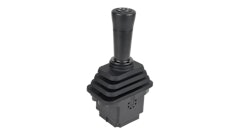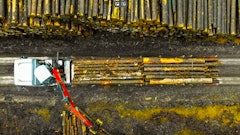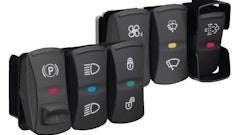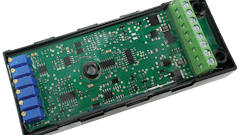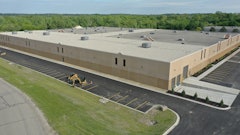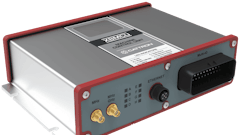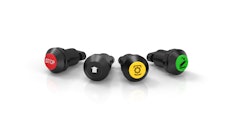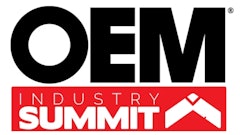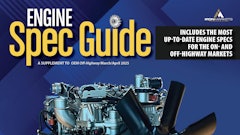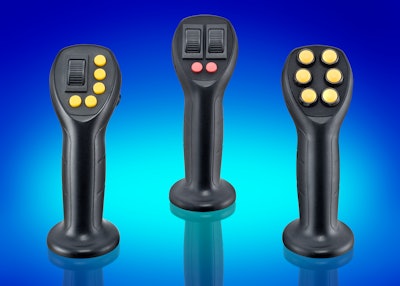
From agricultural vehicles and powered access platforms, to backhoe excavators and airport fire and rescue vehicles, Penny + Giles – a business group of Curtiss-Wright Controls and designer and manufacturer of high precision sensing technology – has extensive experience in providing solutions for monitoring and control under extreme operating conditions.
The Penny + Giles range includes rotary and linear position sensors, tilt sensors and joystick controllers, all of which are used extensively throughout the off-highway equipment industry.
A recent example includes the company’s JC6000 joystick controllers, which are being used by Dynapac, part of the Atlas Copco Group and one of the world’s most experienced manufacturers of compaction and paving equipment.
The application required a change from mechanical to electronic joysticks, prompted by some issues with the driver controls in earlier cabs. These were resolved by the selection of the Penny + Giles JC6000 joystick, which was first specified as part of the new cab control system for a Tandem Asphalt Roller. The cab and JC6000 have since been rolled out across many new models, new platforms and other, larger machines, ranging from 7 to 20 tonnes operating mass.
On Dynapac’s new CA5000 range of Soil Compactors, the JC6000’s primary function is as a speed controller – pushing the handle forward moves the machine forward and the farther it is pushed the faster the machine accelerates. Pulling back provides the same function in reverse. In addition, the JC6000 also features a ‘friction-hold’ mechanism that allows operators to maintain the vehicle at a constant speed when the joystick is released, and leaving them free to steer with a conventional steering wheel while monitoring the progress of the operation and focusing on other functions. For example, one of the functions available via buttons on the joystick controller’s handle is the control of jets, which are used to water-lubricate the drums to prevent them sticking to the material being compacted.
Another example includes the use of Penny + Giles SRH502P rotary position sensors, which are being used for a closed-loop boom angle application for a reach stacker. Here, Hall effect sensors are mounted where the boom pivots on the truck and are used to measure the angle controlled by a Penny + Giles JC6000 joystick controller. While the joystick controls the hydraulic lifts the sensor provides feedback on the angle it has achieved.
The advantage of Hall effect technology over the previously specified single-output potentiometer-based sensor, is the elimination of signal noise due to potentiometer track wear, which could cause problems with position, angle, etc. The Penny + Giles SRH502P was specified because it offers the same mounting detail as the previously used sensor and therefore required minimum customer engineering.
Initially only used on new-build reach stackers, the sensor is now retrofitted for all warranty claims and has been life- and compliance-tested, and subsequently qualified, by the customer.
A recent addition to the SRH range is the SRH520CN, a development of the company’s existing SRH501/2P model that integrates additional electronics to provide either J1939 or CANopen options according to ISO/DIS 11898. Both versions also feature a 14 bit non-contact Hall effect sensor offering 0.022 degree resolution.
The J1939 version of the rotary position sensor is factory programmed by Penny + Giles to offer Direction, Baud Rate, Node ID or Frame Rate parameters. The CANopen version offers either Baud Rate or Node ID parameters, but is customer configurable to the CIA standard DS 301 protocol and supports the device profile for DS 406 encoders.
Both CAN bus interface models have shaft side protection to IP69K; a minimum IP67 protection to the rear when the M12 mating connector is attached and fully engaged; and operate from a 9 to 30V DC unregulated supply. OEMs can also specify the measurement range (0 to 360 degrees) and output in a clockwise or anticlockwise direction.
Another recent introduction from Penny + Giles is the JC8000, a new heavy-duty electronic joystick controller that has been specially engineered with a number of high-strength features to make it ideal for applications in physically demanding working conditions such as skid steer loader controls or where operators traditionally use hydraulic joysticks.
The increased strength of the new heavy-duty JC8000 joystick controller has been achieved by increasing the body material around the area that supports the operating lever; increasing the operating lever’s diameter; and changing the lever’s pivot geometry. These fundamental changes have enabled the joystick to handle increased torque and improve the lever’s bending and applied loads.
Designed for the most challenging applications, the JC8000 can withstand a 380 Nm overload on the X and Y axes and 2,000 N on the vertical. It has also been tested to more than 60 million operations (15 million cycles) under laboratory conditions.
To complement the JC8000 (and its heavy-duty JC6000 and JC1500 ranges of rugged joystick controllers), Penny + Giles has also introduced a new multifunctional handle/grip.
The new HE multifunctional handle/grip, which is also available to users and OEMs wishing to fit the handle/grip to mechanical levers, can incorporate as many as 15 functions including three analogue thumbwheel controllers in the front face and a person-present switch to the main grip. It is available with a choice of three different switch types as standard and six different switch button colours. All switches are environmentally-sealed to IP66 and the handle’s flow-in/flow-out design ensures there are no negative effects from water ingress.
The HE handle/grip has been ergonomically designed to fit comfortably in either hand – eliminating the need for separate left- and right-hand mouldings – and its main body is moulded as a single component to improve rigidity and strength and minimise problems arising from the mounting of independent handle halves.
